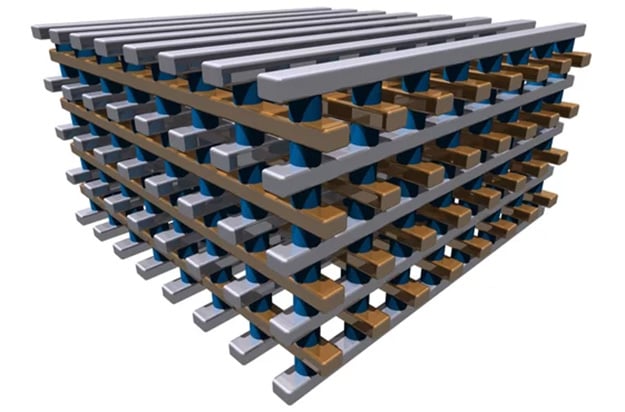Crossbar Is Developing A ReRAM Solution That Could Trump Intel's 3D XPoint Technology
Remember the name Crossbar, in case you are not already familiar with the firm. Founded in 2010, Crossbar has designed a ReRAM (resistive random-access memory) solution that could give Intel and its 3D XPoint technology developed in collaboration with Micron a run for their money. Crossbar's implementation is fast and stable, and also scalable with the ability to be stacked in 3D.
The appeal of solutions like 3D XPoint and ReRAM is that they are non-volatile memory solutions with higher switching speeds and much less power draw compared to NAND flash memory. According to Crossbar, its ReRAM technology is writes data 1,000 times faster than NAND flash, while consuming 20 times less power. It is not quite as fast as DRAM, but pretty close and much more power efficient.

Crossbar's 3D ReRAM structure (Image Source: Crossbar)
Those traits make ReRAM a promising option for mobile gadgets and the growing number of Internet of Things (IoT) devices. It also can withstand a wide range of temperatures, as it is able to operate in environments as cold as -40C and as hot as 125C.
Getting into the nuts and bolts of the technology, a typical ReRAM cell has a switching material with different resistance characteristics sandwiched by two metallic electrodes. The switching effect is based on the motion of ions under the influence of an electric field or heat, and the switching material's ability to store the ion distribution.
There are several challenges that ReRAM solutions must overcome, such as temperature sensitivity and the manufacturing process. Crossbar's solution uses a silicon-based switching material as the host material for a metallic filament formation, which is stable across a wide temperature range. The company is also able to interconnect ReRAM cells in true cross-point memory arrays so they can be stacked, providing high density 3D arrays that can scale to below 10nm.
While mobile and IoT are two sectors where ReRAM could show up, Crossbar also touts the benefits of using its technology in solid state drives.
"Compared to traditional Flash memory, Crossbar ReRAM is a much faster, bit-alterable, erase-free operation. Crossbar ReRAM technology delivers 100x lower read latency and 1,000x faster write performance compared to NAND Flash, and doesn’t have the Flash design constraint to build memory arrays in large blocks that can be independently but atomically operated," Crossbar says. "Crossbar’s ReRAM technology can be architected with smaller pages (e.g. 256Byte pages vs. 16KByte pages in NAND) that can be independently re-programmed. This new storage architecture drastically simplifies the complexity of the storage controller by removing a large portion of the background memory accesses required for garbage collection."
According to Crossbar, these technical advantages would manifest in the form of lower read and write latencies, lower energy consumption, and ultimately longer lasting storage solutions.
While Crossbar has been talking about ReRAM for a long time, it is getting to show the technology in action at the SMIC Technology Symposium in Shanghai this week.
The appeal of solutions like 3D XPoint and ReRAM is that they are non-volatile memory solutions with higher switching speeds and much less power draw compared to NAND flash memory. According to Crossbar, its ReRAM technology is writes data 1,000 times faster than NAND flash, while consuming 20 times less power. It is not quite as fast as DRAM, but pretty close and much more power efficient.

Crossbar's 3D ReRAM structure (Image Source: Crossbar)
Those traits make ReRAM a promising option for mobile gadgets and the growing number of Internet of Things (IoT) devices. It also can withstand a wide range of temperatures, as it is able to operate in environments as cold as -40C and as hot as 125C.
Getting into the nuts and bolts of the technology, a typical ReRAM cell has a switching material with different resistance characteristics sandwiched by two metallic electrodes. The switching effect is based on the motion of ions under the influence of an electric field or heat, and the switching material's ability to store the ion distribution.
There are several challenges that ReRAM solutions must overcome, such as temperature sensitivity and the manufacturing process. Crossbar's solution uses a silicon-based switching material as the host material for a metallic filament formation, which is stable across a wide temperature range. The company is also able to interconnect ReRAM cells in true cross-point memory arrays so they can be stacked, providing high density 3D arrays that can scale to below 10nm.
While mobile and IoT are two sectors where ReRAM could show up, Crossbar also touts the benefits of using its technology in solid state drives.
"Compared to traditional Flash memory, Crossbar ReRAM is a much faster, bit-alterable, erase-free operation. Crossbar ReRAM technology delivers 100x lower read latency and 1,000x faster write performance compared to NAND Flash, and doesn’t have the Flash design constraint to build memory arrays in large blocks that can be independently but atomically operated," Crossbar says. "Crossbar’s ReRAM technology can be architected with smaller pages (e.g. 256Byte pages vs. 16KByte pages in NAND) that can be independently re-programmed. This new storage architecture drastically simplifies the complexity of the storage controller by removing a large portion of the background memory accesses required for garbage collection."
According to Crossbar, these technical advantages would manifest in the form of lower read and write latencies, lower energy consumption, and ultimately longer lasting storage solutions.
While Crossbar has been talking about ReRAM for a long time, it is getting to show the technology in action at the SMIC Technology Symposium in Shanghai this week.

